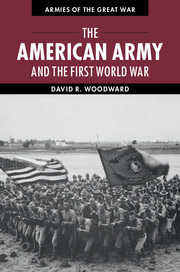Book contents
- Frontmatter
- Dedication
- Contents
- List of figures
- List of maps
- List of tables
- Preface
- List of abbreviations
- Introduction
- 1 Birth of a modern army
- 2 World war and American preparedness
- 3 Coercive power and Wilsonian diplomacy
- 4 “You’re in the army now”
- 5 US army doctrine and industrialized trench warfare
- 6 Over where?
- 7 American Expeditionary Force organization, overseas training, and deployment
- 8 Will the Americans arrive in time?
- 9 Failed expectations: “the military establishment of the United States has fallen down”
- 10 Atlantic ferry
- 11 Neck of the bottle
- 12 Uncertain times
- 13 Cantigny
- 14 Into the breach
- 15 American soldiers in north Russia and Siberia
- 16 The beginning of the end
- 17 Establishment of the American First Army and Saint-Mihiel
- 18 Meuse-Argonne, September 26–October 31
- 19 Breakout, November 1–11
- 20 Epilogue
- Notes
- Bibliography
- Index
11 - Neck of the bottle
Published online by Cambridge University Press: 05 July 2014
- Frontmatter
- Dedication
- Contents
- List of figures
- List of maps
- List of tables
- Preface
- List of abbreviations
- Introduction
- 1 Birth of a modern army
- 2 World war and American preparedness
- 3 Coercive power and Wilsonian diplomacy
- 4 “You’re in the army now”
- 5 US army doctrine and industrialized trench warfare
- 6 Over where?
- 7 American Expeditionary Force organization, overseas training, and deployment
- 8 Will the Americans arrive in time?
- 9 Failed expectations: “the military establishment of the United States has fallen down”
- 10 Atlantic ferry
- 11 Neck of the bottle
- 12 Uncertain times
- 13 Cantigny
- 14 Into the breach
- 15 American soldiers in north Russia and Siberia
- 16 The beginning of the end
- 17 Establishment of the American First Army and Saint-Mihiel
- 18 Meuse-Argonne, September 26–October 31
- 19 Breakout, November 1–11
- 20 Epilogue
- Notes
- Bibliography
- Index
Summary
Pershing’s leadership of the AEF suggested that no objective was more important to him than the formation of an independent American force in France capable of delivering a decisive blow against the German Army. The United States, however, had never created an army of such size and complexity, and it attempted to do so thousands of miles from its factories, raw materials, and farm land. During the prewar years, equipping, supplying, and transporting thousand-man regiments did not present the almost insurmountable difficulties associated with the super-sized AEF division of some 28,000 men. According to Johnson and Hillman, “it demanded twenty-eight times that effort – and General Pershing was asking for a hundred divisions!” Establishing effective lines of communication for an expeditionary force that would grow to some 2 million men by the Armistice was the foundation of everything that would follow. In Harbord’s words, the AEF’s lines of communication were “the neck of the bottle through which all men and supplies must pass.”
In selecting the region of Lorraine as the area in which to establish an all-American army, Pershing could not have selected a theater of operations more difficult for the War Department and Pershing’s staff to sustain. Great Britain, the other great power assisting the French to liberate their homeland, had established its battle front just across the Channel. Difficult lines of communication for the AEF with its own ship berths, warehouses, and in some cases railways, however, was the price that Pershing was prepared to pay to establish an independent army. By war’s end the War Department had shipped 1,500 locomotives, 20,000 railway cars, and 30,410 railway personnel. Even then the AEF failed to establish its own infrastructure that could possibly keep up with the escalating Allied demands for ever more American soldiers. Pershing consequently continued to depend upon the French for vital logistical support, including most of his motorized and animal transport for men and supplies. The United States had horses and mules (although many had been shipped to Europe prior to American intervention) and the industrial base to mass produce trucks, but it did not have the required shipping to get them to Europe. Consequently only 40,000 of the AEF’s 200,000 horses came from the United States and most Doughboys traveled in French trucks driven by Vietnamese.
- Type
- Chapter
- Information
- The American Army and the First World War , pp. 172 - 198Publisher: Cambridge University PressPrint publication year: 2014



